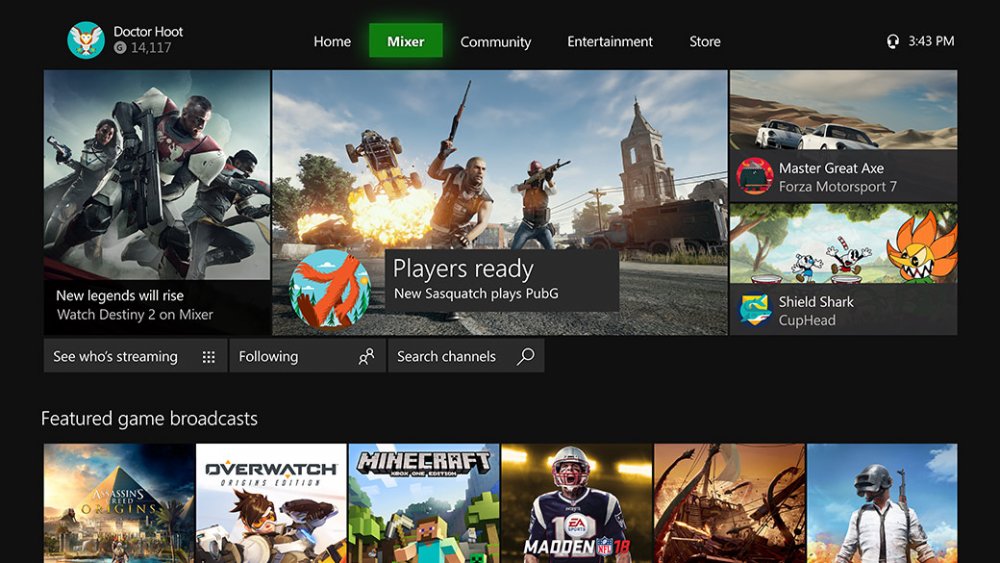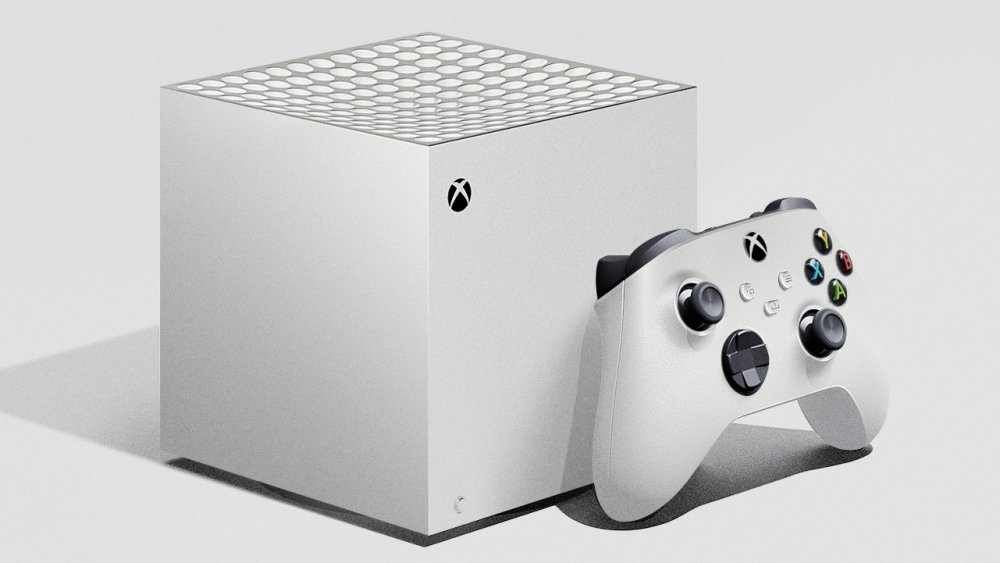The Most Disappointing Things About Xbox Series X
The Xbox Series X is Microsoft's follow-up to the Xbox One, and the Series X is set to have quite a few tricks up its blocky sleeves to impress gamers. The console has features like Quick Resume, which lets players run multiple apps and games in the background — just in case they get stuck and want to watch a walkthrough on YouTube. Plus, the console's Smart Delivery is a sweet deal, since you can purchase an Xbox One version of a game and download the Series X version onto your new console for a next-gen experience. That feature sounds like backwards compatibility on steroids.
However, the Xbox Series X isn't all increased teraflops and fast SSDs. While the console is supposed to be in a different galaxy when compared to the Xbox One, the Series X falls prey to some questionable design choices that are, for a lack of a better term, disappointing. Will they be deal breakers that convince you to buy a PlayStation 5? Probably not, but they still are questionable, if not downright weird.
Here are the most disappointing things about Xbox Series X.
Series X will have the same dashboard as the Xbox One
In the world of gaming, even booting up a console is an entertaining experience. When games only came on physical media, consoles like the PlayStation 2 and Nintendo GameCube only needed to grab players' attention with iconic and catchy boot-up screens. But with the advent of digital download games, console manufacturers had to add eye-pleasing dashboard screens so gamers could scour their digital libraries in style. Traditionally, each console featured unique dashboards to set them apart from the competition and past iterations. But Microsoft has never been one for tradition, and that decision might upset gamers.
The Xbox Series X will upgrade upon every aspect of the Xbox One, providing a superior gaming experience thanks to its downright beastly processing and graphical capabilities, as well as a dizzyingly fast SSD. That's all fine and dandy, but the dashboard UI? Not a single alteration is expected, radical or otherwise. If it ain't broke, why fix it, right? Well, that's part of the problem.
The Xbox One's dashboard isn't broken, but it isn't good, either. Users complain it is a cluttered, annoying mess. Worst of all, some feel the Xbox One dashboard lags like an MMO server experiencing a DDoS attack. The Series X is the perfect opportunity to fix the Xbox One's dashboard woes, but instead, Microsoft is pretending those problems don't exist.
Prepare to stock up on AA batteries
Rechargeable batteries have been around since 1859 (no, seriously). Early wireless game controllers and handheld devices guzzled non-rechargeable batteries, but most console developers have discovered it's more efficient to construct products with rechargeable batteries pre-installed. "Most" is the operative word, since Microsoft still has old-school batteries on the brain.
The Xbox Series X controller will not utilize rechargeable batteries and will instead, according to Eurogamer, use AAs. Sure, nobody batted an eye when the Xbox 360 controller used AA batteries since the Wii Remote, did as well. But gamers asked Microsoft "What gives?" when the Xbox One didn't join hands with the Wii U and PS4 in rechargeable battery harmony. After seven years of experiencing the power of rechargeables, Microsoft still thinks popping AAs every few hours is the way to go.
Microsoft's position is doubly confusing since the company didn't stick to its non-rechargeable guns on the Xbox Elite Wireless Controller Series 2. That pad ditched the AAs and adopted a rechargeable battery, raising the question of why Microsoft won't put a rechargeable battery in an affordable $60 controller. Why must Xbox owners shell out $180 if they don't want to feed their controller AAs? It looks like an answer won't be coming this generation. Maybe next time?
Pack it in for pack-in games
When you bought an Xbox 360, you might have also received a pack-in game or two. What better way to celebrate buying the console than by playing a free game that came with it. The Xbox One, meanwhile, didn't include pack-in games. Surely the Xbox Series X will fix this oversight and once again provide pack-in games, right?
So far, Microsoft hasn't uttered a peep regarding pack-in games. Sure, the company is touting plenty of launch titles, but those are games Xbox Series X owners need to buy separately. All things being equal, this wouldn't mean much since the Nintendo Switch also doesn't include a pack-in game. But all things aren't equal. Each PlayStation 5 will come with Astro's Playroom pre-installed, so that console may already ahead of the Xbox Series X in terms of the cost-to-entertainment ratio — at least if the two machines are similar in price.
Unless Microsoft includes free games with the Xbox Series X, it might once again lose to Sony in another console war.
Expanding your storage might cost a lot of money
In the modern gaming age, hard drive space is a precious commodity. Many digital download titles take up gigabytes of storage, and every Xbox One and PlayStation 4 disc has to install onto the console before a game is playable. Add save data, game updates, and DLC, and your remaining space disappears faster than light in a black hole. You can expand the storage of your Xbox One or PS4 with relatively inexpensive external hard drives. Increasing your Xbox Series X's storage, though? That might end up consuming your wallet.
In PCs and existing consoles, SSDs are more a luxury to speed up loading times. They're not necessary. But the Xbox Series X literally can't run games on a standard hard drive — they're too slow. And that's where issues with expandable storage come into play. Because external hard drives won't be fast enough to keep up with games on the Series X, Microsoft developed a proprietary storage card to match the internal SSD's speed.
More often than not, buying proprietary means spending more. If you're in doubt, ask any Vita owner.
It's worth noting that you can use an external USB drive to store games, transferring them over to your Series X's main drive later on. But that might be a little too time consuming for your tastes. If you want instant access to the entirety of your digital library, prepare to spend more on storing games than you actually spend on the games themselves.
Discs or no discs?
The game industry is embroiled in a war over physical media. On one hand, downloading games is easy. On the other hand, many gamers take pride in their physical disc collections. Both sides have compelling supporting arguments, so you can't say one option is objectively superior, and Microsoft used to cater to both. Not anymore, apparently
When Microsoft announced the Xbox Series X, the company introduced a big, black PC tower of a console with a disc drive. But where was the discless version? After all, Microsoft created the Xbox One S All-Digital Edition as a more budget-friendly option to the Xbox One. That risky gamble paid off, but only after a bit of price finagling. Initially, the All-Digital Edition had a $250 price tag and struggled to sell. But, according to independent game industry analyst Benji-Sales, once it dropped to $150, the console became a hot item during Holiday 2019.
Even Sony has recognized the benefit of offering a cheaper, discless console and is manufacturing the PS5 Digital Edition. But there's not been a peep from Microsoft about a digital edition of the Xbox Series X. There are plenty of rumors about a discless (and possibly cheaper) Xbox Series S, but nothing remotely concrete.
It might be a little too big
Analogies make the world go round. It's more palatable to discuss an unusual idea if you can explain it with concepts others recognize, which is why many people liken the Xbox Series X to a fridge. The console's big and bulky design openly invites these comparisons, which is part of the problem.
When console manufacturers design a new, more powerful console, they often sacrifice compactness for power. The dimensions and shape of the device have to include stronger hardware and also provide effective cooling solutions. And since the Xbox Series X is supposed to be the most powerful Xbox console, it is bigger than prior iterations. It's not quite as tall as the original Xbox One is long, so you might think you could lay the Series X on its side. Just remember that consoles have more than one dimension.
Turns out the Xbox Series X has significantly more volume than the Xbox One X, so placing the Series X on its side will create a sizable black brick that takes up a lot of space. If you try to wedge it into your entertainment center, the console might not fit regardless of orientation. The Series X's size was probably necessary, but it is still too big for its own good.
The gameplay reveal event lacked a lot of gameplay
Trailers are supposed to get audiences excited for upcoming releases, but we've seen how these videos can quickly turn gamers against companies. Trailers with false advertising tend to transform potential customers into life-long critics — look no further than the infamous Watch Dogs trailer and subsequent graphical downgrade. However, there's more than one way to completely botch a trailer, as demonstrated by the "First Look Xbox Series X Gameplay" video.
Usually, audiences expect something very specific when a company releases a gameplay video, and that is gameplay. These videos are supposed to show what a game will look like when audiences get their hands on the controller. However, the Xbox Series X gameplay video had plenty of cinematic trailers and very little in the way of actual gameplay.
Some of the worst examples of gameplay-less gameplay trailers were Scorn and Assassin's Creed Valhalla. Has Scorn undergone any significant gameplay changes since the 2017 alpha gameplay trailer? How does Valhalla change up the combat from Assassin's Creed Odyssey? Since the Series X gameplay trailer was lacking in gameplay, questions like those were left unanswered.
What is the proper orientation?
The Xbox Series X is marketed as a big black obelisk that towers over all your other consoles in terms of size and power. It is designed to dominate your gaming setup and, more importantly, use "innovative parallel cooling architecture" and "three air-flow channels" to keep the console cool under even the heaviest of gaming loads. Moreover, the Series X is supposed to remain as quiet as possible during these gaming sessions, but the question remains: What is the console's ideal orientation to maintain internal temperatures?
Not everyone has the room to place a monolith on their TV shelf, so the Xbox Series X can be laid down horizontally. But, does maintaining your entertainment room's feng shui compromise the console's cooling efficiency? Nobody can agree on this point. Some people believe a horizontal orientation will give vents more room to draw in cool air, while others think the vertical position is the best way to keep it from overheating. Which is the right answer? Microsoft's silence is deafening.
Perhaps the Series X is marketed as a vertical tower because standing it upright maintains the console's temperature, or maybe the console is cool either way. Until Microsoft says one way or another, gamers can't prepare their entertainment centers for either orientation.
Microsoft still doesn't value VR
Almost every modern console is made with VR in mind. Gaming PCs with the latest graphics chips are touted as VR-ready, and gamers can choose from a wide selection of VR headsets. Meanwhile, Sony produces its own proprietary VR headset and games for the PlayStation 4. Even Nintendo jumped on the VR bandwagon with a line of cardboard VR headsets. So where is Xbox VR?
Xbox One has no VR support. The Xbox Series X apparently won't pick up the slack either, since the company has yet to publicly adopt any VR plans. Meanwhile, Sony has already announced the Pulse 3D headset, which will use 3D audio to let players pinpoint sounds in video game environments and seems like it would pair well with a new and improved PlayStation VR for PS5.
Microsoft has an indirect tie to the VR market thanks to Windows 10, and has even dabbled in augmented reality with its HoloLens headset. On the console side, unfortunately, it doesn't appear the company has plans to join the fray.
Teraflops aren't everything
Microsoft claims the Xbox Series X will be the fastest and most powerful console on the market. And to be fair, the company has the numbers to back up its claim, The Series X will sport a beastly 12 teraflops of graphical power, while the PS5 will only include a slightly more modest (but still impressive) 10.28 teraflops. However, the amount of power you have isn't as important as how you use it.
Since the Xbox Series X has more teraflops than the PS5, you might assume it is the better of the two. According to renowned game journalist Jason Schreier and his industry contacts, that isn't the case. On the Kotaku Splitscreen podcast, Schreier stated that looking at the number of teraflops is meaningless. Most if not all of Schreier's contacts agree that the PS5 is a "beast" thanks to its tools, application programming interface (API), and features.
Schreier claimed that, at the end of the day, the number of teraflops is a hypothetical maximum graphical power and speed. The marketing teams might make audiences assume that the Series X's extra two teraflops make it more powerful, but Schreier doesn't think so. Instead, he believes the lineup of games will decide the winner of the console war. Teraflops may end up becoming this generation's blast processing.











